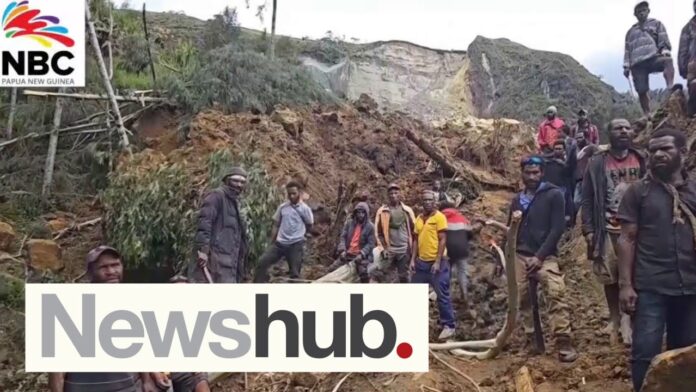Remote location, ongoing tribal warfare, and natural hazards complicate rescue efforts in the Yambali village disaster
The Papua New Guinea government has reported that more than 2,000 people are feared buried alive following a devastating landslide in the remote village of Yambali. The disaster occurred in the early hours of Friday morning when a mountainside collapsed while the village was asleep.
Located in a rugged and isolated area of Enga province, the village’s inaccessibility has complicated search and rescue efforts. The landslide has buried a highway, cutting off Yambali and surrounding villages from the provincial capital of Wabag, approximately 60 kilometres (35 miles) away. Emergency responders have struggled to bring aid, making the final part of their journey on foot due to the rubble blocking the road.
The official death toll is significantly higher than the United Nations’ estimate of 670. So far, rescuers have only recovered the remains of six people. The acting director of Papua New Guinea’s National Disaster Center, Luseta Laso Mana, stated in a letter to the UN that the landslide buried over 2,000 people and caused extensive destruction in Yambali.
Estimates of the casualties have varied widely, and it remains unclear how officials determined the number of affected individuals. The village, home to at least 4,000 people, is in a mountainous and forested region, making access and communication difficult.
Challenges for Rescuers
The rescue operation faces multiple challenges. The landslide left debris six to eight meters (20 to 26 feet) deep, covering an area the size of several football fields. For days, rescuers used only shovels and picks until an excavator arrived. However, survivors resisted using heavy machinery to avoid harming the bodies of their relatives, causing the excavator to be withdrawn on Monday.
Military engineers with additional heavy equipment are en route from Lae, 400 kilometers (250 miles) away, and are expected to arrive by Tuesday or Wednesday. Meanwhile, tribal warfare in Enga province continues to complicate the response. Soldiers have had to provide security for aid convoys, which can only travel during daylight hours due to security risks. Recent clashes between rival clans have led to additional fatalities and property destruction, further straining resources.
Ongoing Hazards
Emergency crews face the threat of additional landslides as the area remains unstable. Waterlogged debris from streams buried by the landslide increases the risk of further slides, prompting evacuations of communities downstream. The International Organization for Migration has expressed concern that the death toll could rise, with ongoing instability making rescue operations perilous.
Immediate Needs and Long-Term Assistance
With the destruction of small farms and food gardens, the survivors of Yambali face severe shortages of food and clean water. The buried streams, once a source of drinking water, have left the community reliant on alternative supplies. Justine McMahon, country director of CARE International, emphasized the urgency of relocating survivors to stable ground and providing essential resources such as food, water, and shelter.
The disaster has affected an estimated 6,000 people. If survivors relocate to urban areas, this could lead to additional economic and social challenges. Porgera and other towns beyond Yambali are now only accessible by helicopter, and the needs of those communities remain unclear.
Call for International Aid
On Monday, the Papua New Guinea government formally requested international assistance. The United States and Australia, the country’s most significant aid donor, have expressed their readiness to help. Papua New Guinea, with a population estimated between 10 and 17 million, sits on the Pacific Ocean’s “Ring of Fire,” an area prone to earthquakes and volcanic activity.
The landslide highlights the vulnerabilities faced by remote and impoverished communities in such volatile regions. As rescue operations continue, the focus will be on providing immediate relief and planning for long-term recovery.
Analysis:
The landslide disaster in Papua New Guinea reveals critical challenges in emergency response and recovery efforts in remote and conflict-prone areas. This analysis examines the political, social, and logistical implications of the disaster and the international response.
Politically, the disaster underscores the need for robust disaster management and infrastructure in Papua New Guinea. The government’s request for international aid highlights the country’s limited capacity to handle large-scale emergencies independently. Strengthening local governance and disaster preparedness can enhance resilience and reduce dependence on external assistance.
Socially, the impact on the Yambali community and surrounding areas is profound. The loss of life, displacement, and destruction of livelihoods will have long-lasting effects. The ongoing tribal warfare exacerbates the situation, complicating rescue efforts and posing additional risks to survivors and responders. Addressing these social dynamics is crucial for effective recovery and long-term stability.
Logistically, the remote location and challenging terrain hinder immediate relief efforts. The delay in deploying heavy machinery and the need to transport equipment from distant cities illustrate the logistical difficulties. Enhancing infrastructure and access in remote areas can improve response times and effectiveness in future disasters.
The international response plays a vital role in the immediate aftermath and long-term recovery. Coordination between international agencies, local authorities, and communities is essential for efficient aid delivery and rebuilding efforts. The support from countries like the United States and Australia can provide much-needed resources and expertise.
Economically, the disaster will likely have significant repercussions. The destruction of subsistence farms and food sources will increase reliance on external aid and disrupt local economies. Long-term recovery efforts must focus on rebuilding livelihoods and infrastructure to restore economic stability.
Environmental considerations are also critical. The risk of additional landslides and environmental degradation requires careful management. Sustainable rebuilding practices can mitigate future risks and support environmental resilience.
In conclusion, the landslide disaster in Papua New Guinea highlights the complexities of emergency response in remote and conflict-affected areas. Addressing the immediate needs of survivors and planning for long-term recovery requires a multifaceted approach involving local, national, and international stakeholders. Strengthening disaster preparedness, enhancing infrastructure, and addressing social dynamics are essential for building resilience and reducing the impact of future disasters.
